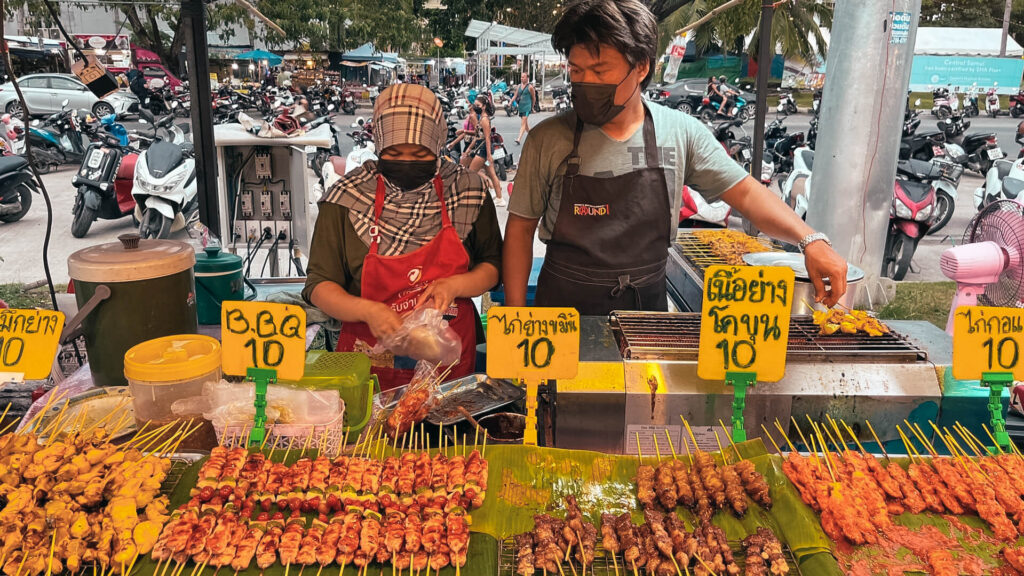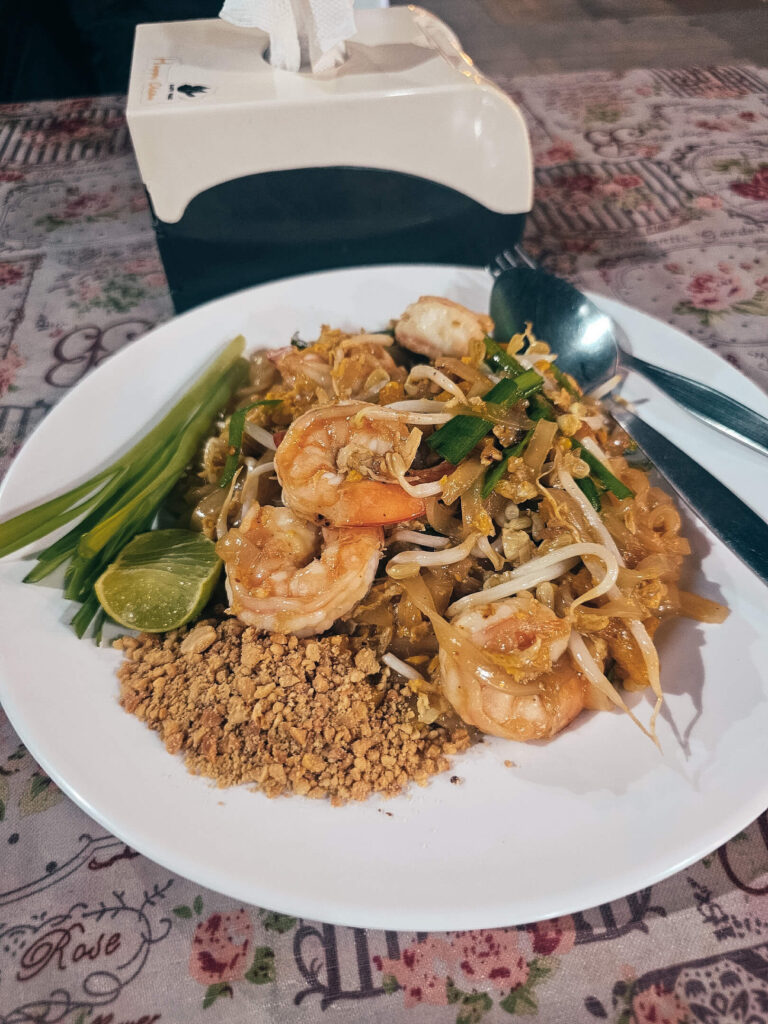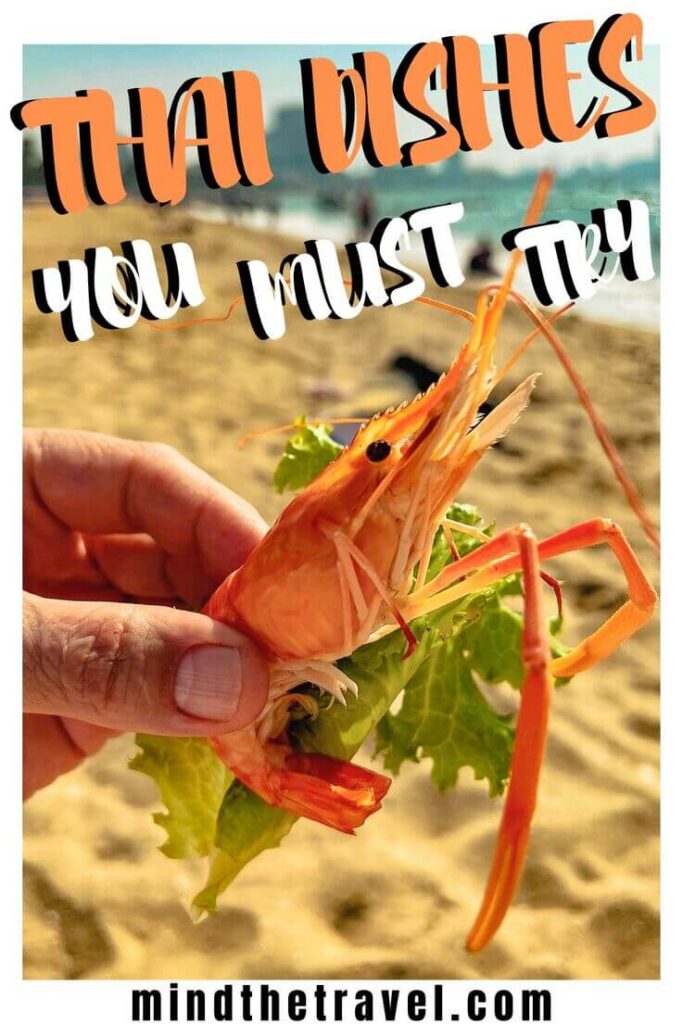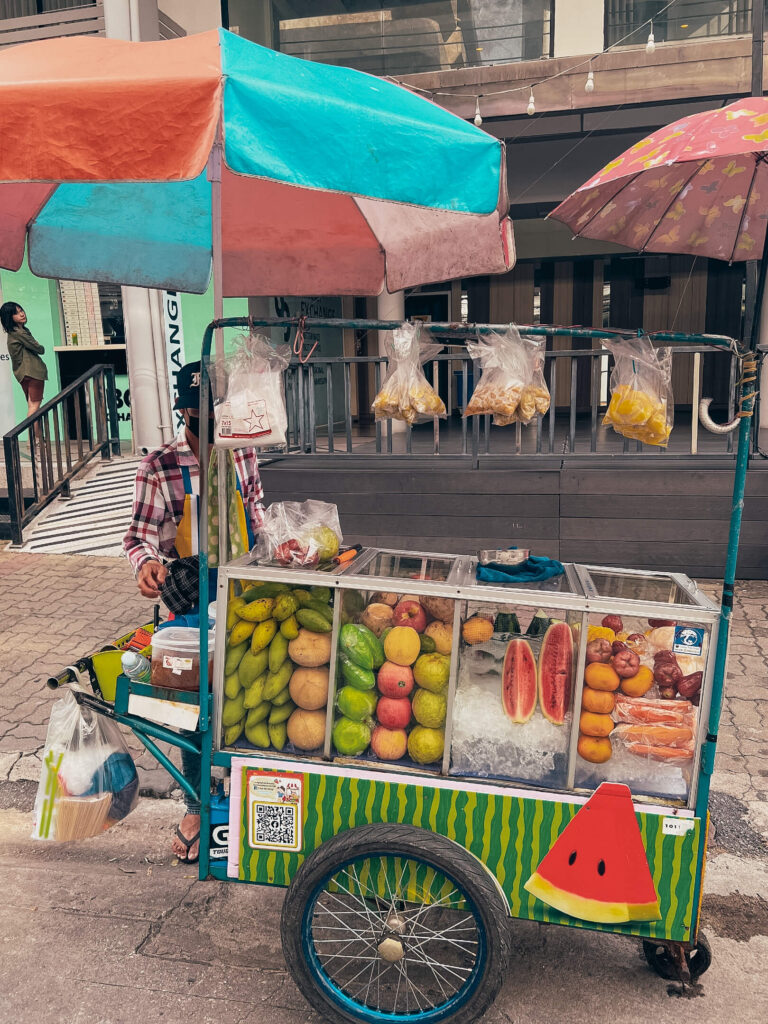27 Popular Thai Dishes You Must Try in Thailand
Renowned for their vibrant flavors, intricate profiles, and fiery essence, Thai cuisine captivate the palate with a harmonious blend of sweet, sour, salty, and spicy notes. A true haven for food enthusiasts. I’ve curated a selection of the best Thai dishes to try in Thailand on your upcoming culinary journey.
Thai cuisine is a symphony of spiciness, freshness, sweetness, and tanginess, showcasing a multi-dimensional approach to flavor. Thai culinary creations are celebrated for their bold tastes and aromatic spices, ensuring a memorable dining experience with each bite.
Without a doubt, Thai cuisine stands out for its rich and robust flavors that never fail to excite the taste buds.
I’ve spent a considerable amount of time living and traveling across Thailand, immersing myself in the intricacies of Thai cooking. If I were to rank our preferred cuisines worldwide, Thai cuisine would undoubtedly claim a top spot, if not the pinnacle.
From indulging in culinary delights at esteemed Thai eateries to savoring street food delicacies, my culinary journey in Thailand has been extensive and enlightening.
In this article, I aim to unravel the mysteries of most popular Thai dishes, shedding light on the common elements found in Thai cuisine and highlighting the regional diversity across the country. Most importantly, I’ll reveal a curated selection of the finest Thai dishes. From popular favorites that grace every menu to hidden culinary gems that demand a bit of sleuthing to uncover.
For all Thai cuisine lovers seeking an authentic culinary journey, a trip to Thailand promises a feast for the senses. So here is my comprehensive guide to Thai cuisine that will ignite your passion for savoring the delectable flavors of our favorite culinary tradition.
Interesting Facts about Thai Food Culture
Thai cuisine delights the taste buds through a harmonious fusion of four essential seasonings. These are salty, sweet, sour, and spicy. They are often meticulously interwoven to create delectable dishes. The intricate balance of these flavors is a hallmark of Thai culinary tradition, evident in nearly every Thai meal. For those averse to spicy fare, rest assured that there are ample options available sans the heat.
Meal-sharing holds significant cultural importance in Thailand, where dining alone is considered ill-fated. When ordering from street vendors, expect dishes served in communal platters, intended to be shared among the dining party present.

In the spirit of communal dining, it is customary to serve modest portions of 1-2 spoonfuls of a dish at a time. Overserving oneself may be perceived as greed in Thai culture, emphasizing the importance of being considerate towards fellow diners.
Unlike other Asian countries, Thai dining etiquette typically eschews chopsticks in favor of a spoon and fork. This utensil preference offers a practical and convenient dining experience, with the fork used to guide food onto the spoon.
Throughout your travels in Land of Smiles, you may often encounter the question “Gin Khao Yung,” meaning “have you eaten?” This warm hospitality exemplifies the Thai people’s profound passion for culinary delights. With offerings of culinary delights extended to guests at any time of the day.
Beyond its sumptuous flavors and cultural significance, Thai cuisine is celebrated for its affordability. You can relish a generous meal for as little as 40 Thai Baht, equivalent to less than $2, leaving you thoroughly satiated.
Armed with these insights into Thai food culture, let’s delve into a culinary exploration of the best Thai dishes to try in Thailand.
Essential Guide to Thai Food
27 Best Dishes to Try in Thailand
Amidst a plethora of tantalizing flavors waiting to be explored, selecting the best Thai dishes can be a challenging task. For an unforgettable culinary journey through Thai cuisine, here are my top 5 recommendations:
- Khao Soi;
- Som Tam;
- Tom Kha Gai;
- Tom Yum;
- Pad Thai.
Continue reading for in-depth insights into each of these dishes and additional recommendations for must-try dishes in Thailand.
1. Khao Soi
Originating from Northern Thailand, Laos, and Myanmar, Khao Soi is an irresistible egg-noodle soup that captures my taste buds.
Crafted with a sumptuous coconut curry, reminiscent of massaman but lighter, the orange-yellowish sauce boasts a subtle spiciness, creamy texture, and an abundance of flavors.
This velvety soup is adorned with crispy egg noodles, pickled mustard greens, cilantro, and lime, with the noodles also boiled and immersed in the savory sauce.
In its most authentic rendition, the rice noodles are steamed and meticulously cut with scissors. A traditional technique prevalent in Chiang Mai and other Northern Thai cities.
For a taste of this exceptional dish, head to restaurants in the northern regions of Thailand, where Khao Soi often features as a standout specialty. Among the memorable Khao Soi experiences, Khao Soi Maesai in Chiang Mai stands out as a top recommendation.
A true gem of Northern Thai cuisine, Khao Soi is a delightful coconut curry noodle soup. It is embellished with egg noodles, pickled cabbage, shallots, a chicken leg, and crispy noodle toppings.
I first tried this dish during my visit to Chiang Mai, it quickly became a favorite due to its rich, aromatic essence and satisfyingly filling nature. Though variations exist based on the chef’s preferences, Khao Soi consistently exudes a captivating blend of flavors and textures.
2. Som Tam (Green Papaya Salad)

This spicy green papaya salad is another culinary staple from Thailand. This salad is a ubiquitous presence on menus, street stalls, and dining tables across Thailand.
It’s hard to imagine a bustling market without the sight of Thai women skillfully preparing this dish that transcends the realms of a mere side or appetizer.
Som Tam is a common and budget-friendly offering at eateries throughout Southeast Asia. It draws locals and backpackers alike with its high flavor profile and low-calorie content.
Variations of this dish abound, incorporating elements like salty shrimp flakes and nutty toasted peanuts to enhance its taste.
For vegetarians, Som Tam stands out as an excellent choice in a cuisine predominantly featuring seafood.
Som Tam is often crafted from green papaya, tomatoes, carrots, long beans, peanuts, lime juice, garlic, palm sugar, and galangal. This salad presents a harmonious blend of five vibrant flavors: sweet, spicy, salty, sour, and savory.
In Bangkok and Central Thailand, Som Tam tends to lean towards the spicier side, despite the sweet nature of papaya being the primary ingredient.
3. Tom Kha Gai
Translating to “chicken galangal soup,” Tom Kha Gai embodies a harmonious blend of sweetness, sourness, and a subtle touch of spiciness. It makes this soup an exceptional introduction to Thai cuisine.
Crafted with a flavorful chicken stock base, this soup features a velvety infusion of coconut milk, galangal, kaffir lime leaf, and lemongrass.
Often enriched with tender chicken and mushrooms, this Thai classic is garnished with aromatic cilantro and chilies, enhancing its vibrant flavors.
Reflecting influences from neighboring Laos, Tom Kha Gai boasts a lighter texture and milder spice levels compared to other traditional Thai fare. This simple yet deeply comforting soup encapsulates the essence of Northern Thai culinary traditions.
While less commonly found as street food, Tom Kha Gai is a prevalent offering in restaurants across Thailand and beyond. For an authentic experience, indulge in this delightful soup at casual eateries in Chiang Mai.
4. Tom Yum Goong (Spicy Shrimp Soup)

This popular Thai soup, known for its bold flavors, predominantly features shrimp as its main ingredient, making it a favored choice among seafood enthusiasts.
There are also other ingredients included: lemongrass, bird’s eye chilies, kaffir lime leaves, galangal, fresh lime juice, shallots, fish sauce, and coconut cream for a creamy rendition. Tom Yum offers a tantalizing medley of tastes and textures.
Characterized by its spicy profile, this soup packs a fiery punch, making it ideal for spice aficionados.
For those seeking a milder alternative, Tom Kha Gai (Chicken in Coconut Soup) offers a delightful variation. While Tom Kha Gai shares similarities with Tom Yum Goong in terms of spices, the option to forgo chilies provides a more subdued flavor profile.
In place of seafood, tender chicken strips and aromatic Asian mushrooms are used to prepare Tom Kha Gai, catering to those with a preference for non-seafood options. This soup serves as a perfect choice for those looking to explore Thai cuisine without delving into chili-laden dishes.
5. Tom Yum
Being one of Thailand’s most esteemed soups and a culinary gem in Thai cuisine, Tom Yum is a tantalizingly spicy, hot, and sour soup crafted with succulent prawns.
Featuring a myriad of variations, Tom Yum soups come in an array of broths with diverse colors, textures, and embellishments, often categorized into clear and creamy renditions.
The traditional Tom Yum base comprises lemongrass, kaffir lime leaves, galangal, and a profusion of crushed red chili peppers, infusing the soup with its signature spiciness.
At local markets, one can easily procure a bundle of all the requisite ingredients for preparing Tom Yum. With an option of utilizing a jarred paste for added flavor. Such is the popularity of this dish in Thailand!
The shrimp heads and shells lend a rich, savory seafood essence to the soup, while the harmonious blend of lime and chilies creates a delightful sensory explosion. Truly a culinary delight that tantalizes the taste buds!
Originating in Central Thailand but embraced throughout the nation, Tom Yum graces food courts, casual eateries, and upscale dining establishments alike. Whether enjoyed as a light lunch or an appetizing starter, ordering this iconic Thai dish is a convenient and delightful choice. Even when time is of the essence.
6. Moo Satay (pork satay)
Moo Satay, popular across Southeast Asia, ranks among my top choices for street food. Prepared over charcoal at night markets, roadside booths, and virtually anywhere else, it’s a snack or light meal you must experience!
“Moo” translates to pork in Thai, and while chicken and beef satay are also savored, the pork variant particularly stands out for its flavor and texture.
Marinated in coconut milk, infused with lemongrass, and a touch of curry powder, this dish serves as a far more accessible introduction for novices to Thai cuisine than many other dishes. To top it all, it’s typically accompanied by a delightful peanut sauce!
To try it, look out for street stalls all over Thailand, particularly those equipped with large charcoal grills. In Bangkok, Satay Tee Tha Din Daeng is an excellent place to try Moo Satay, with over 7,500 satay skewers prepared per day!
7. Pad Med Mamuang (Thai cashew chicken)
Also known as gai pad med mamuang or gai pad med, this dish exudes a burst of flavors and boasts a vibrant array of colorful ingredients. It often includes dried red chilies, yellow peppers, and green peppers, that add to its visual allure.
Gai pad med mamuang is a straightforward Thai cashew chicken recipe featuring succulent chicken and toasted cashews enveloped in a delectable sauce.
This dish strikes a perfect balance of saltiness and spiciness, offering simplicity, quick preparation, and a delightful meal ready in under 30 minutes.
Pad med mamuang, a beloved Thai stir-fry, combines protein, crunchy cashews, and bell peppers in a harmonious medley.
Served alongside rice, this Thai cashew stir-fry is cherished for its gentle yet flavorful blend, rendering it a popular favorite in Thai culinary traditions.
In gai pad med Mamuang, chicken and cashew nuts take center stage, mingling with an assortment of vegetables like onions, bell peppers, and water chestnuts.
This dish showcases the superior quality of locally grown cashew nuts from Phuket, renowned for their exquisite taste and texture.
8. Pad Kra Pao (Thai basil pork)

An ardent enthusiast of street food, overlooking Pad Kra Pao on any culinary list of most popular Thai dishes is unthinkable.
This classic Thai street food marvel consists of fried minced pork paired with fragrant basil leaves atop a bed of rice, a ubiquitous offering in Thailand’s culinary landscape.
Central to Pad Kra Pao’s allure is the fiery touch of basil, lending a spicy kick to the dish.
For those with varied tastes, Pad Kra Pao can feature shrimps, squid, beef, or chicken in lieu of pork.
Even the supposedly “not spicy” variant carries a notable heat, often serving as a gateway for Western palates into the realm of fiery Thai cuisine.
A sought-after ‘one plate’ meal frequently savored in Thai eateries, Pad Kra Pao embodies a delectable sweet and spicy harmony.
In this tantalizing dish, a medley of fresh chilies, garlic, green beans, shallots, fish sauce, palm sugar, minced pork, and peppery basil leaves are skillfully stir-fried in a scorching wok. Then stir-fried is generously ladled over a portion of steamed white rice and crowned with a crispy fried egg.
The minced pork can be seamlessly substituted with chicken, beef, duck, seafood, or tofu to cater to diverse preferences.
Renowned as holy basil stir-fry with pork, Pad Kra Pao stands as a beloved and easily prepared Thai gastronomic gem.
The crux of this dish lies in the aromatic holy basil, imparting its distinctive essence to the amalgamation of minced pork stir-fried with garlic, chilies, and soy sauce.
A swift and straightforward recipe, Pad Kra Pao ensures a burst of flavor with every bite.
9. Pad Thai (Stir-Fried Rice Noodles)

A quintessential Thai dish that you’ll encounter in virtually every Thai restaurant worldwide. Pad Thai holds a special place as one of Thailand’s iconic national dishes. Often the first choice for newcomers exploring Thai cuisine, this flavorsome meal is a staple on menus across the country.
Thai chefs craft Pad Thai by stir-frying rice noodles with a blend of ingredients such as shrimp or chicken, eggs, peanuts, lime juice, bean sprouts, and onions. Whether dining at the most luxurious restaurants or vibrant food stalls, you’re likely to encounter Pad Thai. Locals like it for its sweet and sour profile rather than spiciness.
Pad Thai is often referred to as one of the most popular Thai dishes for beginners. Although Pad Thai is hailed as Thailand’s national dish, its origins are traced back to Chinese immigrants in the 20th century.
During World War II, amid a rice shortage, the prime minister championed Pad Thai as a noodle substitute. This led to its widespread popularity across the nation.
10. Guay Teow
This is yet another beloved Thai cuisine readily available across Thailand. The soup can be prepared using chicken, pork, or beef, coupled with egg or rice noodles.
Street food sellers often incorporate meatballs and garnish the dish with sugar, lime juice, or fish sauce. Guay teow can be enjoyed at any hour of the day. A variant of this dish that’s ubiquitous is Char Guay Teow, the dry, grilled version of the dish.
11. Pad See Ew

Pad See Ew is another stir-fried noodle dish with roots in Chinese cuisine. It is prepared with caramelized and charred flat noodles that impart an appetizing smoky flavor.
The distinctive charring effect is achieved by heating a wok to extremely high temperatures, which leads to flare-ups and appetizing burnt fragments.
Traditionally, like many other noodle dishes, Pad See Ew is prepared with pork and Chinese broccoli. However, once in Thailand, you’ll find variations of Pad See Ew rice noodles cooked with beef, pork, shrimp, and even tofu for vegetarian.
Deliciously tangy yet sweet and savory, observing street chefs as they caramelize the elements of this Thai dish is a sight to behold!
Pad See Ew is a typical street food found all across Thailand. If you want to try it, keep an eye out for vendors with high output volume. The more frequently a wok is used, the more of the wok-hei (“wok breath” literally), the characteristic savory, smoky flavor is infused into the dish.
I must admit, I was unfamiliar with Pad See Ew until my recent journey to Thailand. So, what exactly is Pad See Ew? This fried noodle dish is somewhat akin to Pad Thai, but the inclusion of soy and oyster sauces makes Pad See Ew slightly sweeter.
Traditionally, like many other noodle dishes, Pad See Ew is prepared with pork and Chinese broccoli. However, once in Thailand, you’ll find variations of Pad See Ew rice noodles cooked with beef, pork, shrimp, and even tofu for vegetarian.
12. Massaman
Massaman is a dish with a history spanning hundreds of years in Thailand. It merges influences from across Asia to concoct a mildly spicy yet complexly flavored curry.
With its roots in Muslim traditions, the curry embodies influences from Persia and India, cultures that had interactions with Thailand over several ruling empires.
Intriguingly, as a result, Massaman is rarely prepared with pork and follows halal preparation methods.
Islamic traders brought spices such as cardamom, cinnamon, cloves, and nutmeg to Thailand on their trade routes from Malaysia and India. While these are not typically featured in traditional Thai cooking, they are incorporated into Massaman.
The curry is prepared with dried peppers, garlic, galangal, shallots, lemongrass, and the aforementioned Middle Eastern spices. Such a wide array of influences culminates in a uniquely extraordinary flavor, making it one of the most exotic Thai dishes!
Massaman is commonly found throughout Central and Southern Thailand. Look for it on the menus of small, family-owned restaurants or high-end dining establishments.
13. Larb
Larb is the national dish of Laos. It also holds significant popularity in Northern Thailand with numerous local adaptations. Essentially a meat salad, Larb is typically prepared with a variety of minced meats such as chicken, pork, or beef, or a mixture of these.
In some instances, the meat is served raw, while at other times, it’s stir-fried. The dressing is tangy and spicy, composed of lime juice, fish sauce, and often, an incredibly generous quantity of chilies.
Despite its intense heat, don’t let that deter you from sampling Larb. Before the spiciness kicks in, the dish unveils a vibrant flavor profile, abundant with numerous spices and herbs.
Moreover, each chef adds their own personal touch to Larb, making it truly one of the most distinctive Thai dishes!
Larb is a common street food throughout Northern Thailand and one of the most popular Thai dishes with beef. Don’t hesitate to try Larb from a street stall. Every variation I’ve tasted has proven to be brimming with flavor!
14. Poh Pia Tod (Thai spring rolls)
Thai fried spring rolls serve as a tantalizing starter, boasting a thin golden-brown crust enveloping savory meats and vegetables.
This Thai dish is prevalent across Asia and a mainstay in American takeaway offerings, often accompanied by a sweet chili sauce.
In Thailand, Poh Pia Tod usually features fillings like shrimp, pork, or chicken, alongside carrots, mushrooms, bean sprouts, and a range of other vegetables.
Similar to the U.S., these rolls are typically served with a chili sauce, but it’s worth noting that the Thai version is spicier.
To try it, look for street stalls with large pots of sizzling oil. If your timing is spot-on, you can seize a roll or two fresh out of the oil!
Poh Pia Tod also frequently appears as an appetizer in casual dining establishments.
15. Pla Kapung Nueng Manao
Pla Kapung Nueng Manao is a delightful dish featuring a whole fish, typically Asian Bass steamed with lime, lemongrass, and chilies. The conventional cooking method renders the flesh tender while enhancing its flavors, making the dining experience both fun and unique!
The sauce essentially doubles as a soup, flooding the base of the dish with a light broth bursting with citrus, garlic, and chilies, perfect for dipping.
Particularly if you’re seeking a respite from the abundance of fried or grilled street food in Thailand, this dish serves as a healthier alternative.
Pla Kapung Nueng Manao is usually served in seafood-focused restaurants. In Bangkok they serve whole fish prepared in a variety of styles. It’s an ideal choice for a memorable group dining experience!
16. Pad Krapow (basil stir-fry)
Pad Krapow is a revered Thai dish. It is a stir-fry featuring Holy Basil with a distinctive earthy, herbaceous taste found uniquely in this basil variety.
This delectable dish, prepared with minced pork, chicken chunks, or even shrimp, harmoniously blends spicy green chilies with a luscious dark sauce comprising oyster sauce, fish sauce, soy sauce, and sugar.
Typically accompanied by fragrant jasmine rice and crowned with a crispy sunny-side-up egg, Pad Krapow is a culinary gem.
Alongside Pad Thai, another Thai street food favorite, Pad Krapow reigns supreme among Thailand’s diverse culinary offerings.
Its appeal lies in the succulent meat chunks, intricate spice combination, and a delightful touch of sweetness that culminate in a truly gratifying dining experience. You might find yourself tempted to indulge in a second serving!
To savor this flavorful dish, look no further than the numerous Pad Krapow street stalls and casual eateries scattered across Thailand.
If you’re looking for one of the most popular Thai dishes in Bangkok, Pad Krapow fits this definition pretty well.
17. Green Curry
Though termed Gaeng Khiao Wan or “sweet green curry” in Thai, don’t be misled by the name. It is in fact the spiciest amongst all Thai curry varieties—which is indeed quite a statement! The deceptive name actually pertains to the hue of green and not the flavor.
Thai green curry, brimming with a multitude of peppers, lemongrass, galangal, garlic, and cilantro, is less greasy and more vegetable-centric in flavor.
The curry is thickened with coconut milk and typically served with chicken and rice, then garnished with Thai basil. Despite making you sweat, the flavors make the heat absolutely worthwhile!
As a common Central Thai dish, many restaurants offer their own interpretation of this classic recipe. Sanguan Sri, a restaurant in Bangkok that’s been preparing Thai green curry in the same style for over 50 years.
18. Red Curry
Red curry paste, the most prevalent among all curry varieties, is sold nationwide and exported globally.
Traditionally, red curry is prepared with chilies, galangal, lemongrass, shrimp paste, and coriander as the core ingredients. It is then mashed into a moist paste using a mortar and pestle.
The curry is thickened with coconut milk, and virtually all types of meat and seafood can be added once the curry is ready. Although whole chicken, beef, and pork are the most typical, I’ve seen red curry prepared with frog!
Red curry is served across diverse settings, ranging from casual eateries and street food booths to upscale restaurants. Red curry paste, the most prevalent among all curry varieties, is sold nationwide and exported globally.
19. Panang Curry
Strongly influenced by Malaysian culinary traditions, Panang curry is predominantly found in Southern Thailand. The dish is essentially a creamy, oil-rich, and substantial sauce that is characteristic of the region.
The curry’s base comprises peanuts, dried chilies, cumin, galangal, and various other spices. Kaffir lime leaves, an essential ingredient, imparts a uniquely zesty and bright flavor to the curry. The coconut oil is deliberately separated, rendering the curry less broth-like and endowing it with a thicker texture.
Panang curry is typically served with pork, although chicken and beef variants are also frequent in Thai cuisine.
Like other curries, Panang curry versions can be found in virtually all types of food establishments across Southern Thailand.
20. Khao Pad (Thai fried rice)
Thai Fried Rice ranks among the most scrumptious street foods in Thailand. It is also one of the most wallet-friendly meals available in the nation!
Prepared with aromatic jasmine rice, a mainstay in Thai cuisine, street vendors incorporate an impressive array of ingredients into the rice.
Common inclusions are tomatoes, eggs, and garlic, but you’re equally likely to come across Khao Pad with bacon or pineapple, or even crab.
The sauce strikes a perfect balance of sweetness, saltiness, and acidity, crafted with soy sauce, sugar, and fish sauce.
In Thailand, fried rice is almost always accompanied by raw cucumbers, lettuce, and tomatoes.
As a highly popular street food, explore different versions of Khao Pad from a variety of stalls to discover your personal favorite.
21. Kai Jeow (Thai omelet)
Thai omelets, with their tantalizing crisp exterior and tender insides, make for a delightful and affordable breakfast or snack option.
Available at incredibly low prices, some as low as 30 baht (approximately $1) from street food vendors, these treats are a popular choice among locals.
Prepared with rice, these omelets are infused with the savory flavors of green onions and fish sauce before being expertly scrambled and cooked swiftly in a sizzling-hot, oil-laden wok.
Variations may include additional ingredients mixed into the eggs or the omelet enveloping herbs, chicken, or crab.
Despite their unassuming appearance, Kai Jeow omelets boast a surprisingly intricate flavor palette, blending textures and tastes harmoniously.
For an exceptional dining experience, head to the renowned Jay Fai in Bangkok. This is a Michelin-starred establishment featured on Netflix’s Street Food Series.
Here, the talented chefs, expertly prepare Kai Jeow omelets featuring succulent crab for a truly memorable culinary adventure.
22. Pla Pao (Thai Grilled Fish)
The culinary magic begins by stuffing the fish with lemongrass, encrusting it with coarse salt, and then grilling it over an open flame.
Once cooked to perfection, the fish, typically the popular Barramundi variety prevalent in the Indo-Pacific region, is served alongside fresh leaves, fragrant herbs, and zesty chili sauce.
Despite its seemingly dry exterior, the fish surprises with its tender and succulent flesh, a testament to the culinary artistry involved.
To relish this flavorful delicacy, seek out Pla Pao grilled fish at various street markets across Thailand. Its distinctive appearance, with the whole fish elegantly coated in salt on the grill, makes it a standout dish not to be missed!
23. Guay Tiew (boat noodle soup)
A Thai iteration with Chinese roots, Guay Tiew offers a diverse array of noodle soups under its broad umbrella.
These soups range from those featuring creamy, thick, almost fettuccine-like sauces to others boasting clear broths ideal for savoring every slurp.
A distinguishing factor of Guay Tiew lies in the cut and size of the noodles. This is because some vendors allow customization options for diners to select their preferred noodle type, broth, and spice level. Common toppings include chicken, beef, and an assortment of veggies such as bell peppers, celery, and broccoli.
For a delectable encounter with various noodle soups, seek out casual eateries across Thailand that specialize in Guay Tiew. Each of them offers unique flavors, spice levels, and noodle varieties to cater to diverse preferences.
24. Kao Ka Moo
Known by various regional spellings, and sometimes simply referred to as Ka Moo or Kha Mu, this dish features slow-cooked pig’s trotter, or more bluntly, pig’s foot.
Typically paired with jasmine rice, eggs, pickled greens, and a sipping broth, Kao Ka Moo offers a satisfying culinary experience.
Despite the unconventional choice of meat, do not hesitate to sample this dish as it surprises with its tenderness and delectable taste. This fact makes it one of the most flavorful Thai delicacies. The aromatic pork sauce complements the dish’s components harmoniously, resulting in a well-rounded and comforting meal.
Influenced by Chinese cuisine, Kao Ka Moo boasts a rich and savory flavor profile rather than leaning towards sour or spicy notes. Particularly popular in Bangkok, many eateries specialize in preparing this dish as their signature offering.
For an exceptional dining experience, head to Charoen Saeng Silom in Bangkok. The restaurant is renowned for its critically acclaimed Khao Kha Moo featuring pork knuckle in a flavorful gravy.
25. Pad Woon Sen (stir-fried glass noodles)
This dish comes with an assortment of vibrant veggies like carrots, cabbage, bean sprouts, and onions. Pad Woon Sen is a stir-fry that harmonizes crunchy textures with tender noodles, creating one of Thailand’s most iconic dishes: a traditional noodle delight.
The signature sauce strikes a balance between sweet and salty, achieved by blending oyster sauce, soy sauce, fish sauce, and sugar.
The glass noodles, transparent after cooking, are crafted from vegetable starch, predominantly mung beans but occasionally incorporating sweet potatoes or peas.
This attribute renders Pad Woon Sen a lighter, more delicate option compared to other Thai culinary offerings.
For an authentic experience, seek out Pad Woon Sen at night markets and casual eateries, where this dish, much like other stir-fried noodle variations, is both affordable and widely available.
26. Thai Roti (banana pancakes)

Originating from India, Roti has seamlessly integrated itself as a popular street snack in Thailand. It showcases a unique twist, particularly when served in sweet incarnations, doubling as a delectable dessert option.
The eggy and airy wheat dough of Thai Roti boasts a slightly thicker consistency compared to its traditional Indian counterparts.
This versatile treat is often paired with savory curries or transformed into a delectable dessert adorned with slices of bananas and drizzled with condensed milk.
Much like the theatrical displays seen at crepe stalls globally, Thai street vendors take pride in showcasing their adeptness in skillfully stretching out the dough before it hits the cooking surface.
For connoisseurs seeking an authentic experience, the myriad variations of Thai Roti await exploration at bustling night markets, offering a diverse array of both sweet and savory renditions to tantalize taste buds.
27. Kao Niew Mamuang (Mango Sticky Rice)

A journey to Thailand remains incomplete without savoring the iconic Mango Sticky Rice. A dessert deeply ingrained in local culture and adored by Thais who relish it in small servings throughout the day.
This delectable treat harmoniously blends glutinous rice, luscious mango, and fragrant coconut syrup, delivering a symphony of flavors.
Known as Kao Niew Mamuang, Mango Sticky Rice presents a delightful ensemble of warm, sweet sticky rice bathed in velvety coconut milk and crowned with juicy mango slices. it offers a distinct taste and texture unparalleled by ordinary desserts.
Enhanced with a sprinkle of sesame seeds, a side of coconut cream, and occasionally roasted cashews, this indulgent treat is best enjoyed on balmy Thai evenings.
Following a day of exploration, treat yourself to this traditional Thai delicacy for a satisfying dessert experience.
Noteworthy is the meticulous presentation of Mango Sticky Rice at Tikky Cafe in Chiang Mai, setting a high standard for this revered Thai dish.
Essential Thai Ingredients
Encompassing a harmonious blend of diverse tastes, Thai cuisine is all about using an array of distinctive ingredients. When they come together they create unparalleled culinary experiences.
The heat of bird’s eye chilies. The freshness of lemongrass and Thai holy basil. The earthy notes of ginger and galangal. The zesty tang of limes unite with garlic, sugar, and fish sauce to define the tantalizing flavors of Thai dishes.
A standout component in Thai cuisine is the aromatic kaffir lime leaf, sourced from a non-edible lime tree. It infuses dishes with an indescribable essence that sets Thai cuisine apart.
This unique flavor profile is enhanced by a selection of commonly used ingredients:
Coconut Milk
A creamy base extracted from brown coconuts, utilized in curries and soups.
Ginger
Adding a subtle pungency and a hint of sweetness.
Thai Chili (Birds’ eye chili)
Providing fiery spice and heat, distinct from jalapenos.
Lime
A key acidic element in Thai cuisine, enhancing dishes and serving as a garnish.
Shallots
Offering a delicate sweetness and a punch akin to garlic.
Thai Basil
A spicier variant with notes reminiscent of black licorice.
Galangal
A citrusy-piney root in the ginger family, integral to curries.
Kaffir Lime Leaves
Contributing bright, citrusy, floral flavors to curries and sauces.
Garlic
Thai garlic, sweeter and smaller, often used with the shells intact.
Lemongrass
Featuring a subtle lemony-mint profile, seamlessly complementing other ingredients.
Fish Sauce
A salty, savory staple crafted from salt and fish, enriching the depth of Thai flavors.
Additionally, most Thai restaurants, offer spice condiment trays containing dried chili flakes, fish sauce with chilies, vinegared chilies, sugar, and other essential items. Such an approach allows diners to customize their dishes to suit their preferences.
Decoding Thai Cuisine: Thai Food Vocabulary
In Thai cuisine, certain words frequently appear in the names of dishes, providing valuable insights into what to anticipate with each culinary creation.
Understanding these terms can help unravel the essence of each dish:
- tom: Signifies boiled dishes;
- yam: Indicates spicy salads;
- tam: Represents pounded or mashed foods;
- gaeng: Denotes curries;
- pet: Indicates spiciness;
- phak: Refers to vegetables;
- too-eh lee-song: Highlights the presence of peanuts;
- guaidtiao: Points to noodle dishes;
- kâao: Refers to rice;
- moo: Signifies pork;
- gai: Represents chicken;
- wua: Denotes.
Things You Should Know About Thai Cuisine
Having accumulated over 1.5 years of combined experience living in and traversing Thailand, I’ve gathered valuable insights and advice regarding Thai food.
Here are some noteworthy tips to enhance your culinary journey in the Land of Smiles:
Embrace Plastic Chairs
It’s a well-known fact that when in Thailand sticking to eateries with plastic chairs and a humble ambiance often delivers exceptional fare.
While upscale dining establishments offer their own allure, don’t be quick to dismiss spots with plastic seating.
In my exploration, I’ve discovered that these unassuming locales frequented by locals are culinary treasures, serving up authentic Thai delicacies at reasonable prices.
By gravitating towards these modest establishments, you’ll relish genuine flavors unaltered by exorbitant costs or diluted tastes found at more tourist-centric establishments.
Indulge in Tropical Fruits
Southeast Asia boasts a rich diversity of fruits awaiting your palate. When traversing Thailand, make it a point to sample a wide variety of fruits that the region has to offer.
Among our top picks is the mangosteen, a seasonal delight found in Thailand. This fruit exudes a flavor reminiscent of mango but with an elevated taste profile, making it a personal favorite. Soursop presents another intriguing option, showcasing a delicious and distinctive taste unique to this part of the world.
Now, onto the durian, a divisive fruit that evokes strong opinions—you’ll likely discern your stance based on its distinct aroma! Meanwhile, dragonfruit, while not overly flavorful, captivates with its vibrant appearance, often featured in mixed fruit assortments.
Even fruits you’re familiar with back home, such as pineapple, mangoes, papaya, and bananas, seem to reach new heights of flavor in Thailand, their place of origin.
When exploring local markets or strolling along sidewalks, keep an eye out for vendors selling freshly cut fruits in convenient bags, ideal for on-the-go snacking. These treats often come with wooden skewers for easy consumption. Some fruits, like mangoes, are accentuated with a seasoning blend of chili, salt, and sugar, a popular choice among locals to enhance their natural sweetness.
Typically, Breakfast Consists of Noodles or Rice
Unlike Western breakfasts that often center around egg dishes, in Thailand (and most of Asia, for that matter), you’ll find dishes with rice or noodles that you’d most likely associate with lunch or dinner.
Indulge in Tropical Fruits
Southeast Asia boasts a rich diversity of fruits awaiting your palate. When traversing Thailand, make it a point to sample a wide variety of fruits that the region has to offer.
Among my top picks is the mangosteen, a seasonal delight found in Thailand. This fruit exudes a flavor reminiscent of mango but with an elevated taste profile, making it a personal favorite.
Soursop presents another intriguing option, showcasing a delicious and distinctive taste unique to this part of the world.
Now, onto the durian, a divisive fruit that evokes strong opinions—you’ll likely discern your stance based on its distinct aroma! Meanwhile, dragonfruit, while not overly flavorful, captivates with its vibrant appearance, often featured in mixed fruit assortments.
Even fruits you’re familiar with back home, such as pineapple, mangoes, papaya, and bananas, seem to reach new heights of flavor in Thailand, their place of origin.
Pin It For Later









Nidhi Thawal
I just love thai cuisine a lot!
Tracey Clark
Great photos! You’re making me crave some pad thai!
Amelie Dobie
Wish I could eat Thai food right now! Well done!
Pooja Kumari
Oh, this looks so amazing and tempting. Definitely a worth try! Thanks for sharing!
Jyoti
I absolutely love Thai cuisine and your blog does total justice! The pictures are awesome and the description just right.
I hosted a Thai party a few ago. Next time I do it, I’ll use this blog to plan my menu.
Joleisa
I’ve never had any of those dishes before! I would really love to visit Thailand though so now it is on my bucket list and it is very high!
The foods look and sound delicious
Sabina
The food looks delicious! Never been in Thailand but I tried some Thai dishes in Dublin, and loved it.
Gabby
All of this food looks delish! I am visiting Thailand in April so I can’t wait to dig into these types of eats! Thanks for the great tips!
Leah
I know what I’m getting for lunch today! Yum! I love Thai food.
Jennika Argent
Oh gosh this has made me Hungry! Thai food is my fave. Never tried the mango rice but it’s on the list now. I’ll have to find a recipe somewhere